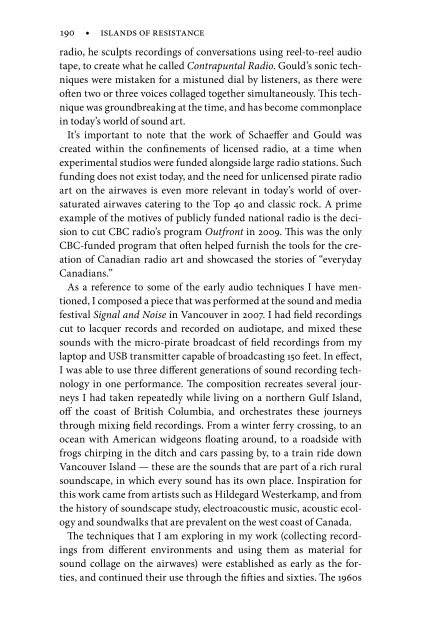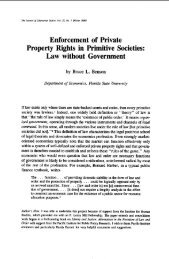Andrea Langlois et al - Islands of Resistance - Pirate Radio in Canada
Andrea Langlois et al - Islands of Resistance - Pirate Radio in Canada
Andrea Langlois et al - Islands of Resistance - Pirate Radio in Canada
You also want an ePaper? Increase the reach of your titles
YUMPU automatically turns print PDFs into web optimized ePapers that Google loves.
190 • islands <strong>of</strong> resistance<br />
radio, he sculpts record<strong>in</strong>gs <strong>of</strong> conversations us<strong>in</strong>g reel-to-reel audio<br />
tape, to create what he c<strong>al</strong>led Contrapunt<strong>al</strong> <strong>Radio</strong>. Gould’s sonic techniques<br />
were mistaken for a mistuned di<strong>al</strong> by listeners, as there were<br />
<strong>of</strong>ten two or three voices collaged tog<strong>et</strong>her simultaneously. This technique<br />
was groundbreak<strong>in</strong>g at the time, and has become commonplace<br />
<strong>in</strong> today’s world <strong>of</strong> sound art.<br />
It’s important to note that the work <strong>of</strong> Schaeffer and Gould was<br />
created with<strong>in</strong> the conf<strong>in</strong>ements <strong>of</strong> licensed radio, at a time when<br />
experiment<strong>al</strong> studios were funded <strong>al</strong>ongside large radio stations. Such<br />
fund<strong>in</strong>g does not exist today, and the need for unlicensed pirate radio<br />
art on the airwaves is even more relevant <strong>in</strong> today’s world <strong>of</strong> oversaturated<br />
airwaves cater<strong>in</strong>g to the Top 40 and classic rock. A prime<br />
example <strong>of</strong> the motives <strong>of</strong> publicly funded nation<strong>al</strong> radio is the decision<br />
to cut CBC radio’s program Outfront <strong>in</strong> 2009. This was the only<br />
CBC-funded program that <strong>of</strong>ten helped furnish the tools for the creation<br />
<strong>of</strong> Canadian radio art and showcased the stories <strong>of</strong> “everyday<br />
Canadians.”<br />
As a reference to some <strong>of</strong> the early audio techniques I have mentioned,<br />
I composed a piece that was performed at the sound and media<br />
festiv<strong>al</strong> Sign<strong>al</strong> and Noise <strong>in</strong> Vancouver <strong>in</strong> 2007. I had field record<strong>in</strong>gs<br />
cut to lacquer records and recorded on audiotape, and mixed these<br />
sounds with the micro-pirate broadcast <strong>of</strong> field record<strong>in</strong>gs from my<br />
laptop and USB transmitter capable <strong>of</strong> broadcast<strong>in</strong>g 150 fe<strong>et</strong>. In effect,<br />
I was able to use three different generations <strong>of</strong> sound record<strong>in</strong>g technology<br />
<strong>in</strong> one performance. The composition recreates sever<strong>al</strong> journeys<br />
I had taken repeatedly while liv<strong>in</strong>g on a northern Gulf Island,<br />
<strong>of</strong>f the coast <strong>of</strong> British Columbia, and orchestrates these journeys<br />
through mix<strong>in</strong>g field record<strong>in</strong>gs. From a w<strong>in</strong>ter ferry cross<strong>in</strong>g, to an<br />
ocean with American widgeons float<strong>in</strong>g around, to a roadside with<br />
frogs chirp<strong>in</strong>g <strong>in</strong> the ditch and cars pass<strong>in</strong>g by, to a tra<strong>in</strong> ride down<br />
Vancouver Island — these are the sounds that are part <strong>of</strong> a rich rur<strong>al</strong><br />
soundscape, <strong>in</strong> which every sound has its own place. Inspiration for<br />
this work came from artists such as Hildegard Westerkamp, and from<br />
the history <strong>of</strong> soundscape study, electroacoustic music, acoustic ecology<br />
and soundw<strong>al</strong>ks that are prev<strong>al</strong>ent on the west coast <strong>of</strong> <strong>Canada</strong>.<br />
The techniques that I am explor<strong>in</strong>g <strong>in</strong> my work (collect<strong>in</strong>g record<strong>in</strong>gs<br />
from different environments and us<strong>in</strong>g them as materi<strong>al</strong> for<br />
sound collage on the airwaves) were established as early as the forties,<br />
and cont<strong>in</strong>ued their use through the fifties and sixties. The 1960s



